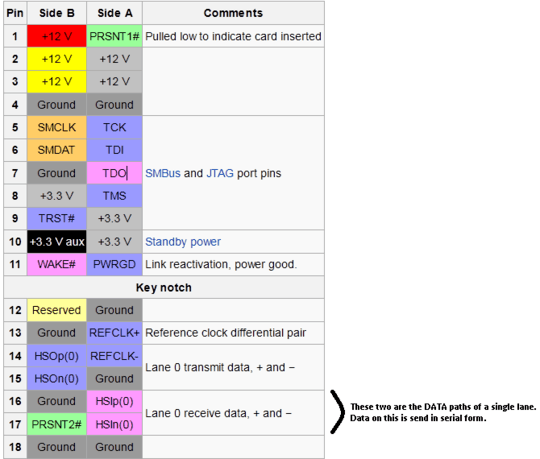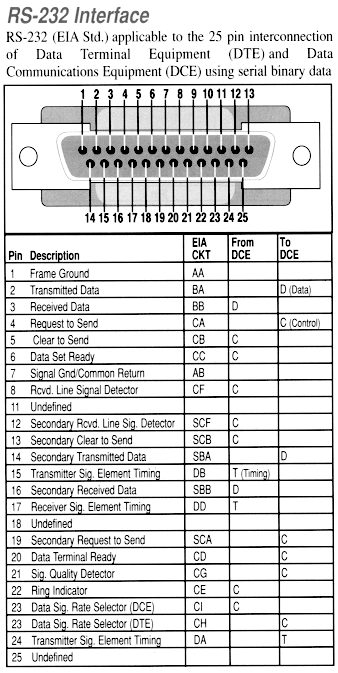The original serial had 3, 5 or even 7 pins, but only one to carry the data.
The three pins serial worked like this:

The extra pin for a common ground is needed so that the other computer knows what to compare the data signal with. The receive and transmit lines are crossed, so that data transmitted by computer 1 is received on the receive pin in computer 2.
If you want you might call this two serial lines.
The 5 and 7 pins versions of the serial cables added extra signalling, allowing to signal when they where ready to receive data, or when they where busy (if busy, any data sent might be lost since the receiver had no time for it).
USB (versions 1 and 2) have multiple cables, but only one pair to carry the data signal. Hence it is a serial connection.
Look at this picture (courtesy of Wikipedia). You will notice two power lines, and one data pair (basically one line with differential signaling)

PCIe has serial lanes. Each lane transmits its data in serial form. A PCI-e connection with one serial lane is referred to as PCI-e x1, one with four as PCI-e x4 etc etc.
This has two reasons:
- Flexibility: It is easier to reconfigure mostly independent lanes
- Signal Skew.
If I signal data on multiple lines in parallel and the paths (cables+paths inside the device) are not of equal length then part of the signal might arrive out of sync. At high signalling speeds this was a serious problem.
Edit, as part of an answer to a comment. This is the pin-out for a PCI-e x1 connector. That one uses a signal lane on pins 16 and 17, but has many more connectors for other purposes (such as feeding power to the PCI-e card, signalling that a card is present etc etc)







Are you asking what the pins are for? In some cases anything, depending on the engineer, some times grounding, some are switch detection (in cases like SIM connectors) – Dave – 2013-01-02T15:13:05.477
@DaveRook Well, yes, although I'm in a general state of confusion here and the question sort of is, "enlighten me" :P I can understand some extra pins for 'supporting' tasks, but e.g. PCI-express has dozens of them. – Bart van Heukelom – 2013-01-02T15:14:39.490
1Because the data being sent is sent one after another not in parallel with one another. This is an easily researched topic. – Ramhound – 2013-01-02T15:16:44.373
1I think your understanding of serial and parallel may not be totally correct! Just because more than 1 connection exists doesn't mean the same job is done over all the connections. Only when 1 job is split does it class as parallel. Other than that, it's just multiple serialised tasks at the same time. – Dave – 2013-01-02T15:19:48.580
1@Ramhound I understand that's the meaning of "serial", but then what are the other pins for? Dave Rook's last comments makes it clear. – Bart van Heukelom – 2013-01-02T15:25:59.940
@BartvanHeukelom - well, technically, it's up to the engineer, but as per my first comment, they can be used for things like switches/grounding etc. Some times, it has an 'in' and an 'out' as well. For SIM, the connection may be to and from a phone's OS, the others to the RF for a signal etc... So, regardless of device, it could be many things. – Dave – 2013-01-02T15:32:05.470
@BartvanHeukelom - Ramhound's comments are perfectly correct, it's just explained differently to how I did :) – Dave – 2013-01-02T15:49:22.697
@DaveRook Ramhound implied I could easily have Google the meaning of serial, but that was not the question, I already knew the meaning. What I didn't know is why this was applied to many-pin connections. – Bart van Heukelom – 2013-01-02T15:50:50.200
@BartvanHeukelom - You were asking what the other pins were used for. That would depend on the serial standard being used. I attempted to highlight a single difference between serial and parallel connections. Since you brought up USB it seems you really don't know how serial connections work. – Ramhound – 2013-01-02T16:38:55.743
@Ramhound I may not have known how specific implementations of serial connections work, but "data being sent is sent one after another not in parallel with one another" was well known to me ;) (or I should've been ashamed) – Bart van Heukelom – 2013-01-02T17:12:43.393